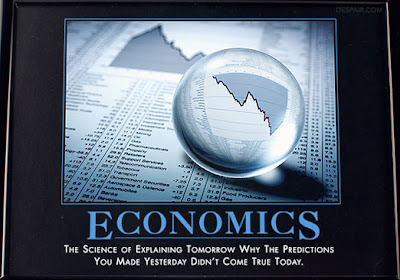As this blog purports to focus on topics relevant to investing, not just behavioral psychology, I will present some evidence that investment strategists, economists and analysts are particularly awful at predicting the future for the economy, stock prices, earnings, or any other series relevant to investor success. Further, these financial prognosticators are vastly overconfident and resistant to data that runs counter to their views.
Before presenting the ugly details, I want to emphasize that investors should not feel disheartened by the evidence that financial marketing and media is dominated by loud, overconfident shills and mountebanks. On the contrary, investors should feel liberated to pursue other interests rather than reading or watching business news. For those that enjoy the cognitive 'sport' of investing from the standpoint of strategy and game theory, feel free to explore the various scenarios with your colleagues and friends as fun dinner conversation. Just don't orient your portfolio on the basis of your conclusions, or the conclusions of other thinkers. You are all bound to be wrong far more often than you are right.
Now, here is the evidence. These charts are sourced from James Montier's book Behavioural Investing (2007):
Chart 1. Consensus bond yields forecasts 1 year out vs. actual
Chart 2. Consensus S&P500 level 1 year forecasts vs. actual
Chart 3. Consensus S&P500 aggregate earnings 1 year forecasts vs. actual
Note that in all cases, strategists, analysts and economists do an excellent job of describing what happened or is currently happening, that is they do an excellent job of observing the obvious. Unfortunately, they demonstrate no predictive ability whatsoever, as their forecast series for likely levels one year out appear to be lagging indicators, not leading ones.
Source: Despair.com
Still not convinced? The following chart shows the percentage error of analyst earnings forecasts from 24 months prior to an earnings announcement through to the date of the announcement, using data from 1986 - 2000. Not surprisingly, analysts demonstrate significant over-optimism in their earnings forecasts from two years out, while their forecasts narrow toward the actual number by around 2 months prior to earnings. The average error at 1 year is approximately 10%, and by a month prior they are slightly pessimistic. Of course this slight pessimism then allows the companies they cover to beat estimates slightly, which often results in a price jump.
Chart 4. The walk down to beatable earnings.
Source: Dresdner Kleinwort Wasserstein Macro Research
The error rate would not be so worrisome if it weren't for the high level of confidence that investment professionals imbue on their predictions. This effect is perhaps best illustrated using the results of a study by Torngern and Montgomery (2004). The study set laypeople (psychology undergraduates, the perennial guinea pigs) against investment professionals in a competition to select the stock that they thought would outperform over the next month from pairs of stocks. All the stocks were well known companies, but participants were given information such as the industry and prior 12-month performance for each stock as well. Participants were asked to choose the best performer from the pair, and to provide their level of confidence in their choice.
Over many picks, one might hope that when participants were 50% confident that their choice was right, they were accurate about half the time, and when they were 90% confident they were right almost all the time. In fact, as you can see from the chart below, a person's confidence level was largely irrelevant to their accuracy over time. In other words, having greater confidence in a choice did not lead to higher accuracy levels. In fact, at extreme levels of confidence (>80%), professionals were actually less likely to get it right. At a 90% level of confidence, professional investors actually got it right only 15% of the time, while at a 55% - 75% level of confidence they achieved about 40% accuracy.
Chart 4: Accuracy and confidence on a stock selection task
Source: Torngren and Montgomery (2004)
It is important to remember that over a 1-month time horizon the results of these stock choices are almost random, so we are not out to skewer professionals on the basis of their accuracy in this test. Instead, we are left to wonder why anyone expressed such high levels of confidence in their choices. When asked this question, laypeople admitted that they were mostly guessing, but also placed some emphasis on the previous month's returns. In contrast, almost no professionals admitted to guessing; instead, they attributed their choices to 'Other knowledge' about the stocks, and 'Intuition'. Incidentally, the only factor with any predictive power in this example, however small, is the previous month's results. It has been well demonstrated that there is a strong mean-reversion tendency in stocks over a 1 month time frame, so participants may have had a slight advantage if they chose stocks with poor previous 1 month returns to outperform over the next month.
Chart 5. Average rating of decision input importance
Source: Torngren and Montgomery (2004)
The quantum leap in thinking that I want to convey with this post is that there is indisputable empirical evidence that the world is too complex to enable accurate forecasting. Axiomatically, people should consider expert forecasts as no more than entertaining narratives - brain candy to stimulate the imagination. Even complex mathematical models are relatively poor predictors of the future beyond a certain time threshold. The best we can hope for is an assessment that a dynamic or trend is likely to stay on a certain course, or alternatively that the course is changing. Forecasting the direction or the magnitude of the change in trend is empirically impossible. We will be spending much more time on trend-following strategies going forward.







No comments:
Post a Comment